HTC One max Review - It's Huge
by Brian Klug on October 28, 2013 10:00 AM EST- Posted in
- Smartphones
- HTC
- Mobile
- One
- Snapdragon 600
- Android 4.3
- One max
Obviously the highlight of the One max is its huge 5.9-inch 1080p display. After all, the huge display is literally the reason for the max moniker and its gargantuan size. It’s still an IPS LCD, and like the One, resolution is 1920x1080. Using the same resolution at larger size means lower PPI, but the One max is still high enough (373.4 PPI) that individual pixels shouldn’t be visible at all.

One interesting thing to note about the One max however is that the android display density is still set to 480 PPI, putting it in the same DENSITY_XXHIGH category as the One. This means that applications will look like scaled copies of what you’d expect them to look like on the One. There’s an interesting ongoing debate about what users really expect from these larger-sized smartphones and the demographic that’s buying them. Do users want scaled, larger applications which are easier to read, or the ability to display more content. HTC oddly enough seems to have scaled parts of their own UI, for example the widget panels are five row instead of four on the One max, and the launcher defaults to the 4x5 size instead of 3x4 which would look downright silly, further the status bar is also smaller.

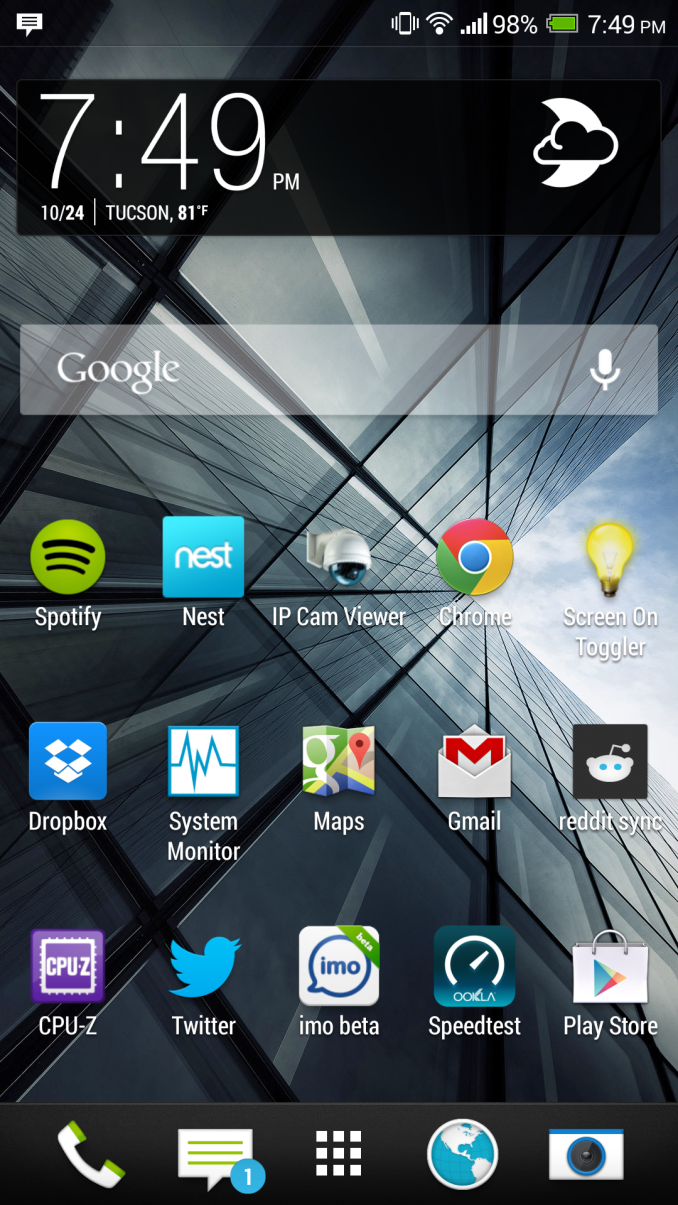
HTC One (Left), HTC One max (Right) – Note the grid and icon size changes
I’m not complaining, it’s just interesting to see 480 in Android but the HTC apps scaled down to give more real-estate, which is what I’d prefer since I have good vision.
One improvement I’m really happy about in Sense 5.5 is a change to the auto brightness function. Rather than just have a checkbox, the One max will allow you to set an upper bound for the auto brightness algorithm. Ideally I would like a higher or upper bound, or a bias function (+/- some delta), but this is a step in the right direction.
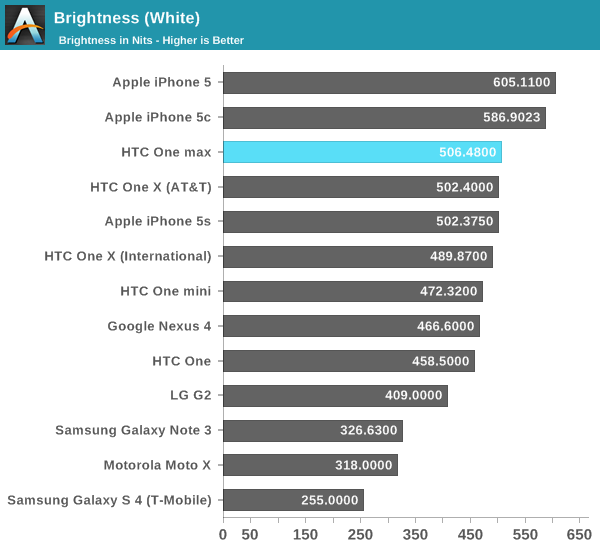
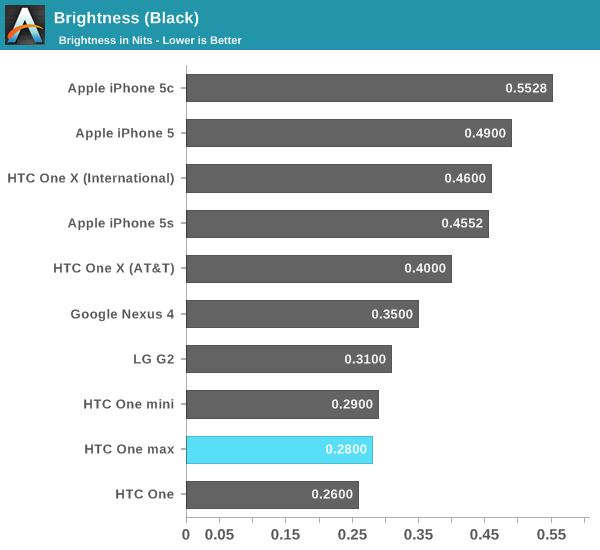
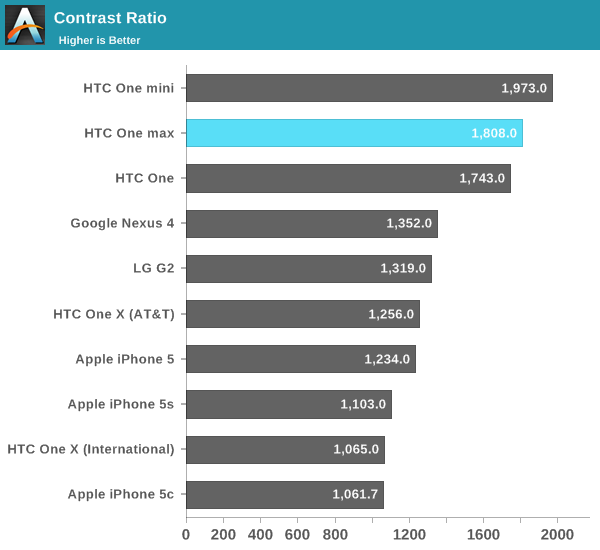
The One max display goes very bright, up to 506 nits, higher than the One or One mini. White point is also a bit more controlled than the One, at 7301 K average. My biggest complaint about the One max is that like the One it has a dynamic brightness/contrast function that adjusts screen brightness as a function of the content being displayed. That alone isn’t a huge problem, it’s just that there’s no way to disable it in the UI, which would be great, since it’s distracting watching screen brightness change as you move around the UI. I would love to see HTC go the Google approach and restrict these functions to full screen video playback, and give the option to turn it off entirely.

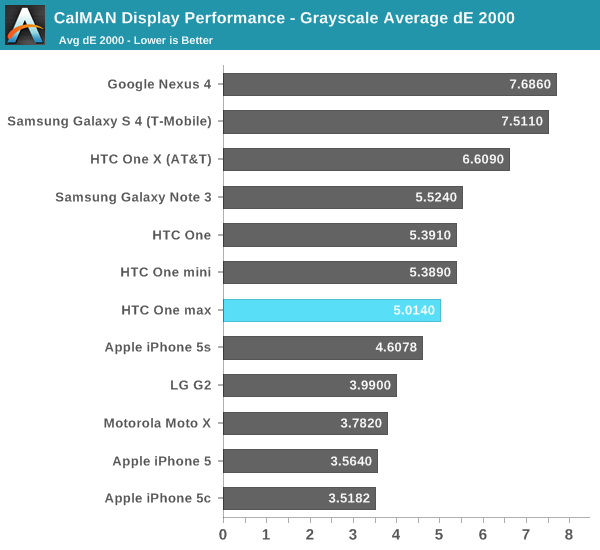
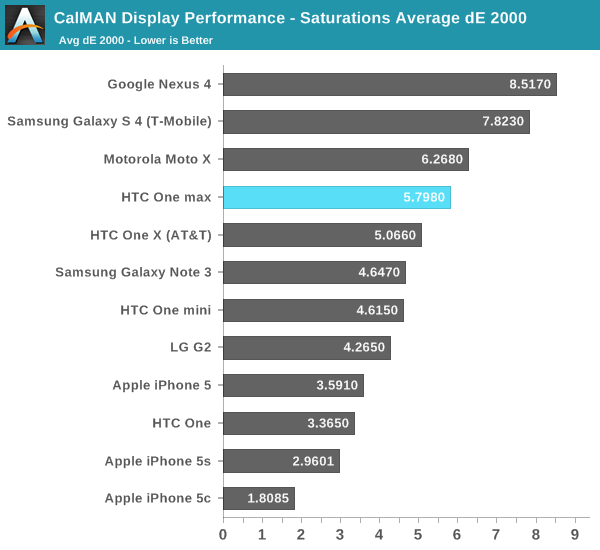


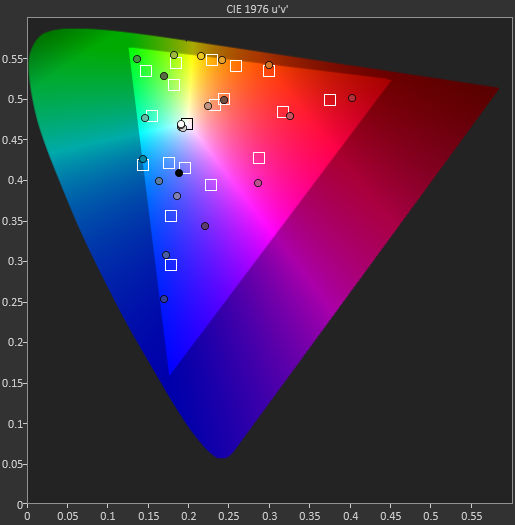
Running it through our display tests, it’s clear that the One max also has a bit of the saturation boost we’ve seen popping up on other phones as well. The saturation curves are great until the second to last point, which is almost set to maximum saturation. I’d love to see even more emphasis on color accuracy for the next generation of phones, the One max seems to be in the general ballpark of the One, but slightly worse.


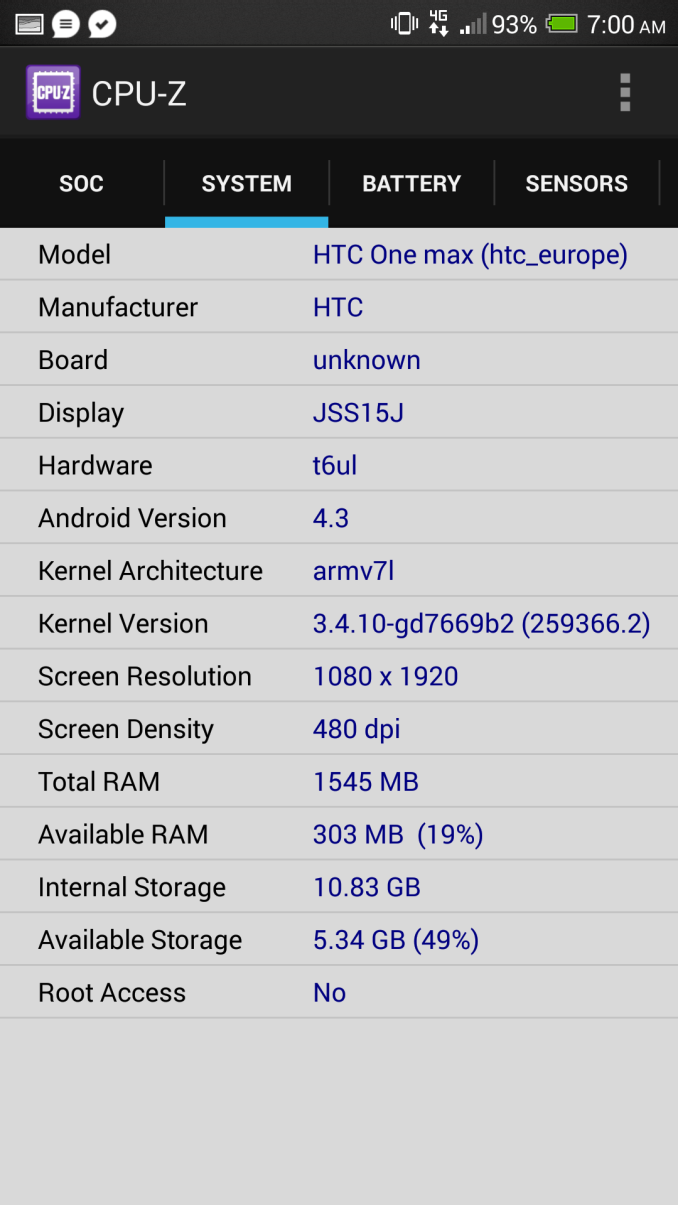
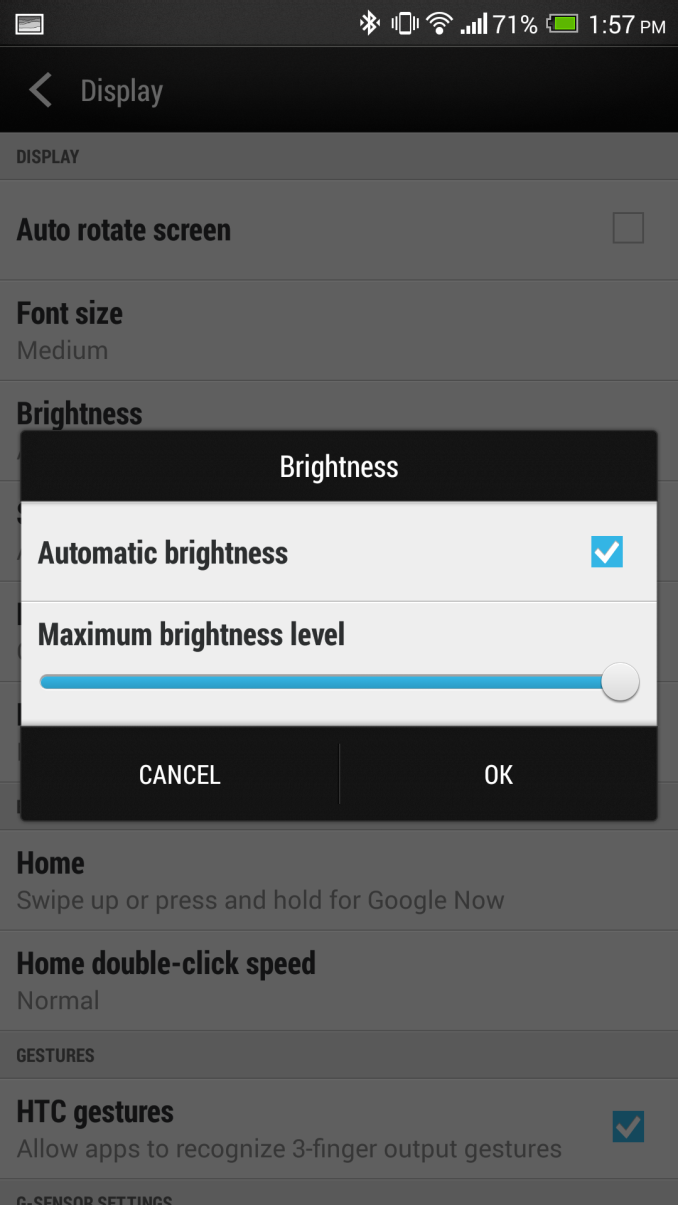









197 Comments
View All Comments
smartypnt4 - Monday, October 28, 2013 - link
One thing people always brag about on Android is consumer choice. If Samsung more fits your needs, more power to you. But I fail to see how removing one of the top tier Android phone manufacturers is a good thing. I don't want any one company to be massively ahead of the rest in market share, because I believe some competition is a good thing and prevents companies from resting on their previous success and putting out crap new products.Say what you will about mircoSD slots. Personally, I don't store much on my phone anyway, so it's not a big deal to me. But please don't espouse the absurd opinion that removing players from the Android space will in any way improve it.
smartypnt4 - Monday, October 28, 2013 - link
Shit. On my phone. Did not mean to reply to you, but rather the guy you commented on. My bad.JeffFlanagan - Monday, October 28, 2013 - link
>Shit. On my phone.OK, but you're going to need a new phone.
nerd1 - Monday, October 28, 2013 - link
HTC one is a nice device but it has too many deal breakers for me and more (no micro sd, sealed battery, almost non-repairable, terrible QC, low-resolution camera)They basically shot their own feet, trying the apple way, while being no apple.
smartypnt4 - Monday, October 28, 2013 - link
Clearly you missed my point. I'm not interested in arguing the merits of a removable battery or microSD card slot. All I'm saying is that dude needs to chill out. If the Android space is truly about choice, what do you care what HTC does as long as SOMEONE makes the phone you want. In this case, HTC's phones this year clearly don't meet your needs/requirements, and that's fine. Saying they shot themselves in the foot is a bit harsh, though. I know several people who bought HTC Ones over SGS4's simply because of how the thing felt when they held the device. Say what you will about specs, features, etc., but not everyone values the same things you do. Hard to accept, I know. But my good lord. Are you really so shortsighted as to believe that the general population gives a rat's ass about removable batteries, SD card slots, phone repairability (wtf?), anecdotal evidence of bad QC, and a camera that makes heavy tradeoffs (in this case, IQ for low-light performance)?Not everyone has exactly the same desires or needs as you. Which is the beauty of the Android space: people have the luxury of choice, which you only get with multiple manufacturers competing in the same space.
/endrant
nerd1 - Monday, October 28, 2013 - link
So the device w/o micro sd slot is effectively $100-200 more expensive than device with one.iPhone 5s 64GB: $399 w/contract, total storage 64GB
S4 16GB + 64GB sdxc : around $200 w/contract, total storage 80GB
I know companies prefer to removing the slot to sell the high capacity devices with greater margin (BOM difference of 16GB and 64GB devices is almost negligible) but why we consumers blindly follow what they are doing?
MKy - Monday, October 28, 2013 - link
I can understand Apple there. Adding an SD card slot would be adding a means for the user to completely ruin the experience. Internal flash of my Ipad 4 reads/writes about 160MB/s, don't know about the newer models. A cheap SD card reads about 4 MB/s, writes even worse. So imagine running apps off it or using it as data storage. Would be painful.Spunjji - Monday, October 28, 2013 - link
Simple solution: Refuse to support cheap-ass storage. Validate some cards and support those, refuse app installation to SD. My 64GB Micro SDXC benches faster than most phone NAND... it cost me £40.kyuu - Monday, October 28, 2013 - link
I haven't been able to find any actual data on the storage performance of the iPad 4 (or any iPad for that matter), but I find your 160MB/s number rather unlikely. The storage used in iPads is the same used in iPhones, to the best of my knowledge, which isn't very fast.MKy - Monday, October 28, 2013 - link
Actually it is that fast. You can find benchmarking tools in the app store and even measure it by hand - open a say 5 gig video in one app and then choose open in another, then count the seconds it takes to copy it over (the delay after issuing the command) and calculate. The flash in iphone 5 is about the same speed.